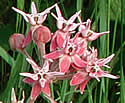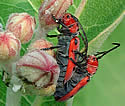Asclepias speciosa (Showy Milkweed)
| Also known as: | |
|---|---|
| Genus: | Asclepias |
| Family: | Apocynaceae (Dogbane) |
| Life cycle: | perennial |
| Origin: | native |
| Habitat: | sun; wet prairies, along shores |
| Bloom season: | June - August |
| Plant height: | 2 to 3 feet |
| Wetland Indicator Status: | GP: FAC MW: FAC NCNE: FAC |
| MN county distribution (click map to enlarge): |  |
| National distribution (click map to enlarge): |  |
Pick an image for a larger view. See the glossary for icon descriptions.
Detailed Information
Flower: 

![[photo of flowers]](/udata/r9ndp23q/pd/asclepias-speciosa-3-t.jpg) Spidery balls of soft purple to almost hot pink flowers each ¾ to 1½ inches long, this milkweed has come by its name honestly. 2 to 4 flower clusters emerge from upper leaf axils and can be 3 inches across. The 5 long, light pink hoods are nearly three times the length of the central flower column and angled out and up, extending beyond the radius of the 5 petals below them. The horns are long and slender, curved in lightly over the top of the flower column but do not reach the center or touch one another.
Spidery balls of soft purple to almost hot pink flowers each ¾ to 1½ inches long, this milkweed has come by its name honestly. 2 to 4 flower clusters emerge from upper leaf axils and can be 3 inches across. The 5 long, light pink hoods are nearly three times the length of the central flower column and angled out and up, extending beyond the radius of the 5 petals below them. The horns are long and slender, curved in lightly over the top of the flower column but do not reach the center or touch one another.
Leaves and stem: 

![[photo of leaves]](/udata/r9ndp23q/pd/asclepias-speciosa-6-t.jpg) Leaves are generally oval, up to 4 inches wide by 8 inches long, broad at the base to finely pointed at the tips, with a reddish mid-vein and little or no leaf stem. Leaf undersides are also hairy with upper surface velvety to smooth on the upper. Leaf edges are toothless, but may be somewhat wavy. This is a colonial species from roots with sturdy stems covered in fine hairs.
Leaves are generally oval, up to 4 inches wide by 8 inches long, broad at the base to finely pointed at the tips, with a reddish mid-vein and little or no leaf stem. Leaf undersides are also hairy with upper surface velvety to smooth on the upper. Leaf edges are toothless, but may be somewhat wavy. This is a colonial species from roots with sturdy stems covered in fine hairs.
Notes:
While the native range is throughout the entire western half of North America it is a decidedly western species in Minnesota most common in remnant wet prairies of the Red River Valley. Showing up in the nursery trade, it requires richer loamy soils and adequate moisture. All Asclepias were formerly in family Asclepiadaceae but have been reassigned to Apocynaceae (Dogbane).
Native Plant Nurseries, Restoration and Landscaping Services ↓
More photos
Photos courtesy Peter M. Dziuk, taken on a wet prairie in Polk County
Comments
Have you seen this plant in Minnesota, or have any other comments about it?
on: 2013-08-01 00:02:49
I found this plant on a State Land Preserve on the east side of Pelican Lake near Ashby. Beautiful! Your site helped me identify it, thank you.
on: 2015-07-11 10:43:32
I saw two plants of this species in bloom at Schaefer Prairie (The Nature Conservancy) in McLeod County on July 10.
on: 2017-07-17 09:04:50
Showy milkweed is the most common type of milkweed in the Assiniboia Skipper Unit section of Felton Prairie and is extremely abundant.
on: 2018-07-05 21:11:28
07-05-2018 Blooming on the beach ridge of Glacial Lake Agassiz - 190th St NW and 280th Ave NW (8 miles SE of Warren MN in Polk Co.)
on: 2021-09-30 11:58:48
Present at County Line WMA
on: 2023-07-30 22:27:56
Same place I find everything, along County Road 101 between Larsmont and Two Harbors. There is on small cluster of these plants. I'm starting to think someone spread some prairie wildflower seeds along this stretch of road, as I am finding a few things in close proximity that are out of place in this location, like coneflowers and indigo.
on: 2023-07-31 08:00:20
Jon, Lake County is definitely out of showy milkweed's natural range so a planting seems likely.







 Showy Milkweed plants
Showy Milkweed plants more flowers
more flowers bugs just wanna have fun...
bugs just wanna have fun...